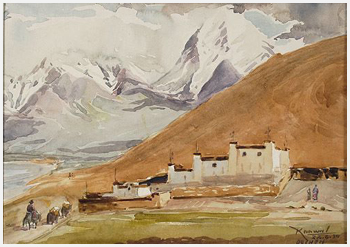EDUCATION
- 1930 Studied at Benaras Engineering College, but
gave up his engineering studies for art. 1933-39 Diploma,
Govt. College of Art and Craft, Kolkata. 1953 Worked
under William Hayter for three months and studied
basic techniques of the graphics medium, Paris.
EXHIBITIONS
1939 AIFACS, Lahore. 1942 Joint Show with Devyani Krishna,
Silver Jubilee Celebration, Benaras Hindu University.
1942 Group show, Banaras Hindu University. 1943 Joint
show with Devyani Krishna, organised by the Roerich
Centre of Arts and Culture, Annie Besant Hall, Allahabad.
1946 Joint show with Devayani Krishna, organised by
French Information Bureau, New Delhi. 1946 Group show,
UNESCO, Paris International Exhibition, New Delhi. 1947
Joint show with Devayani Krishna, AIFACS, New Delhi.
1947 Group show, the Indian section of the International
Exhb. of Modern Art, India House, London. 1947 Two of
his paintings were exhibited, UNESCO Art Exhb., Paris.
1948 Jammu and Kashmir war paintings exhb., inaugurated
by Prime Minister Mr. Jawaharlal Nehru, New Delhi. 1950
AIFACS exhb., Calcutta. 1951 Solo show at Rome. 1952
Solo show, Dramen, Supsberg, Stockholm. 1952 Solo exhb.,
Academy of Fine Arts, Salon, Norway. 1952 Solo show,
Gallery Cappelen, Oslo, Norway. 1953 Group sho
COLLECTION
National Gallery of Modern Art, New Delhi. Ministry
of Defence, New Delhi. Gottinghan University, Germany.
Lancashire University. Gray Foundation, USA. Chitrakala
Parishad, Bangalore. Hyderabad Museum, Hyderabad. R.P.G
Enterprises, Bombay. Duncan House, Calcutta. Reliance
Industries, Bombay. Governor`s House, Orissa. Delhi
Art Gallery, New Delhi.
AWARDS
1939 First Prize, All India Exhb. of Fine Arts, Lahore.
1946 First Prize, International Exhb. of Contemporary
Art, New Delhi. 1950 Gold Medal, Academy of Fine Arts,
Calcutta. 1961 Awarded Gold Medal, Academy of Fine Arts,
Calcutta. 1954 Awarded the First Prize and Gold Medal,
Academy of Fine Arts, Amritsar. 1955 Awarded the First
Prize and Gold Medal, Academy of Fine Arts, Amritsar.
1961 Awarded four Gold medals, including Bengal Governors
gold medal for the best work in any medium, Graphics
and cash awards. 1963 Mention Award at Sao Paolo. 1973
Honoured by the Sahitya Kala Parishad, New Delhi. 1984-85
Honoured by the Ministry of culture with Emirates Fellowship.
STYLE
Kanwal Krishnas love to travel and a life of wandering
gypsy for nearly fifteen years of his life resulted
in an intense love for nature. The mysterious phenomena
of nature, that is light, darkness and space engraved
a deep impression in his mind. Therefore the theme of
nature and its mysteries had been a constant obsession
with Kanwal Krishna all his life. Whatever he thought
there was the land and sky, the wind and the snow, the
apace around and the light. He would try relating this
with his own life and what he sees and experience. For
instance he would relate the inner space in him, and
the pilgrim, with outer space and the total environment.
His early works are characterized by the masterly use
of watercolor. He has painted rugged faces of the hill
people and lamas with psychological insight. His portrayal
of mountains and other landscape shows infinite variety
of natures moods painted spontaneously and skillfully.
The later works impart a glow transparency with images
in crystall
TEACHING EXPERIENCE
1951 Study tour on invitation by Italian Govt. 1952-53
Study tour on invitation by Norwegian Govt. 1957 Invited
by British council, he went to England to teach art
at Hailybury an imperial service college. 1958 Head
of the Art Dept., Modern School, New Delhi. 1964 New
York University gave round the world ticket to travel
and discuss the art of teaching method, in different
countries.

back |



